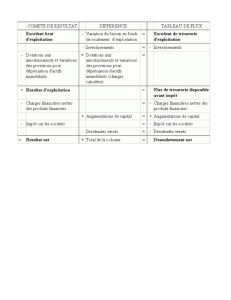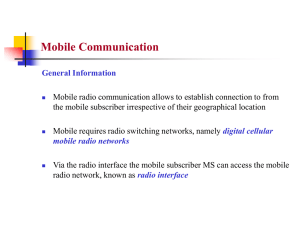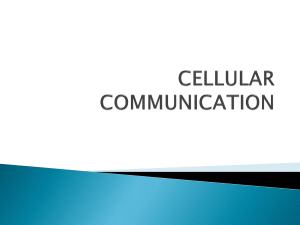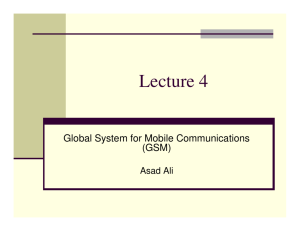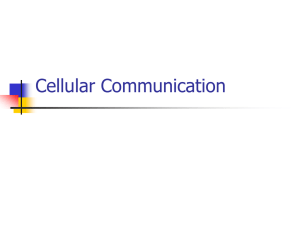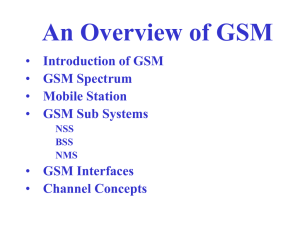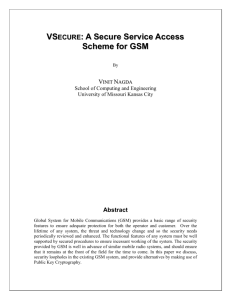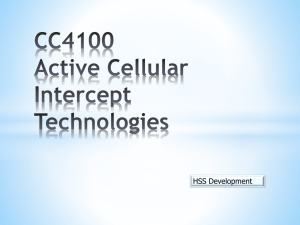Mobile Communications
advertisement
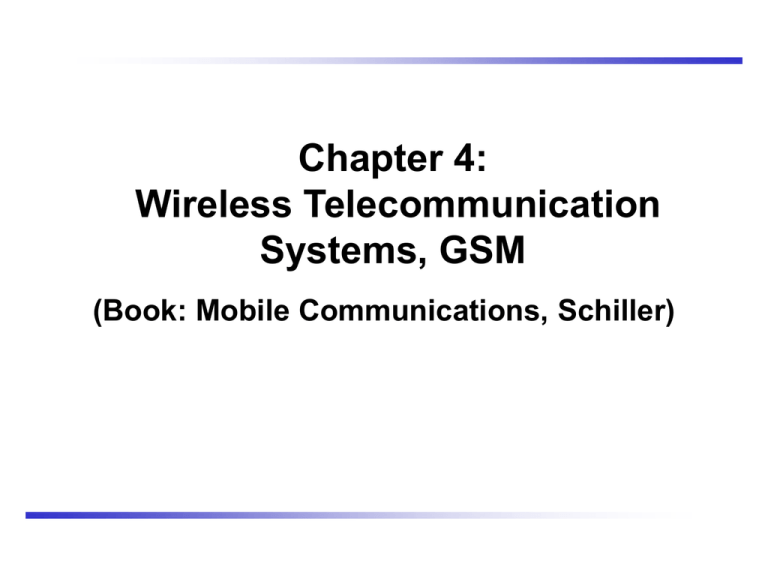
Chapter 4: Wireless Telecommunication Systems, GSM (Book: Mobile Communications, Schiller) GSM: Overview GSM formerly: Groupe Spéciale Mobile (founded 1982) now: Global System for Mobile Communication Pan-European standard (ETSI, European Telecommunications Standardisation Institute) today many providers all over the world use GSM (more than 200 countries in Asia, Africa, Europe, Australia, America) GSM status (end 2006) 2.18 billion connections in 212 countries 82 % market share globally An incredible industry success! GSM – The idea of a common European mobile communications system 1982: A Nordic group is considering the next generation of mobile telephone. – NMT (Nordisk Mobil Telefon), the analogue first generation system has only just been started These ideas are presented to CEPT (European Conference of Postal and Telecommunications Administrations) in June 1982 September 1982: The first meeting in CEPT GSM – Groupe Spécial Mobile In 1988 ETSI (European Telecommunications Standards Institute) is established and the work is continued under a new name: SMG – Special Mobile Group GSM - Specifications Original specifications for the GSM system: Good subjective voice quality Low terminal and service cost Support for international roaming Support for handheld terminals Support for new services Spectrum efficient Compatible with ISDN GSM - Growth 1991: First operational GSM network in Finland: Radiolinja 1993: Tele-mobil (later: Telenor Mobil) and NetCom GSM open their networks in Norway 1998: GSM 1800 is deployed to increase capacity in cities and other densely populated areas Performance characteristics of GSM (wrt. analog sys.) Communication mobile, wireless communication; support for voice and data services Total mobility international access, chip-card enables use of access points of different providers Worldwide connectivity one number, the network handles localization High capacity better frequency efficiency, smaller cells, more customers per cell High transmission quality high audio quality and reliability for wireless, uninterrupted phone calls at higher speeds (e.g., from cars, trains) Security functions access control, authentication via chip-card and PIN Disadvantages of GSM There is no perfect system!! no end-to-end encryption of user data no full ISDN bandwidth of 64 kbit/s to the user reduced concentration while driving electromagnetic radiation abuse of private data possible roaming profiles accessible high complexity of the system several incompatibilities within the GSM standards Architecture of the GSM system GSM is a PLMN (Public Land Mobile Network) several providers setup mobile networks following the GSM standard within each country subsystems RSS (radio subsystem): covers all radio aspects NSS (network and switching subsystem): call forwarding, handover, switching OSS (operation subsystem): management of the network Ingredients 1: Mobile Phones, PDAs & Co. The visible but smallest part of the network! Some GSM terminals Development.. Sony Ericsson W950i ”the Walkman phone” HTC P4350 Pocket computer running Windows Some more GSM terminals Nokia N95 Samsung Blackjack iPhone – Apple’s Mobile phone initiative with ”everything”, e.g. GPS built in Ingredients 2: Antennas Still visible – cause many discussions… Ingredients 3: Infrastructure 1 Base Stations Cabling Microwave links Ingredients 3: Infrastructure 2 Not „visible“, but comprise the major part of the network (also from an investment point of view…) Management Data bases Switching units Monitoring GSM System Architecture Mobile Station (MS) Mobile Equipment (ME) Subscriber Identity Module (SIM) Base Station Subsystem (BSS) Base Transceiver Station (BTS) Base Station Controller (BSC) Network Switching Subsystem(NSS) Mobile Switching Center (MSC) Home Location Register (HLR) Visitor Location Register (VLR) Authentication Center (AUC) Equipment Identity Register (EIR) GSM: overview OMC, EIR, AUC HLR NSS with OSS VLR MSC GMSC VLR fixed network MSC BSC BSC RSS A RADIO CELL Voice Channels Lines to BSC Or control channels MS Location Areas and Base Station SubSystems PSTN MSC BSC 1 BSC 1 Location Area 2 BTS BTS BTS BTS Location Area 1 BTS MSC Areas and Location Areas To PSTN MSC 1 MSC 2 MSC Area 2 MSC Area 1 Location Area 3 Location Area 1 Cell Area Location Area 4 Cell Area Cell Area Cell Area Location Area 2 HLR MSC VLR BSC Mobile Station The mobile station (MS) is the starting point of a mobile wireless network. The MS can contain the following components: • Mobile terminal (MT)—GSM cellular handset • Terminal equipment (TE)—PC or personal digital assistant (PDA) The MS can be two interconnected physical devices (MT and TE) with a point-to-point interface or a single device with both functions integrated. GSM cellular handset GSM cellular handset : Mobile equipment (ME) + SIM card Subscriber Identity Module (SIM) contains encryption key and personal data The user is uniquely identified through ”International Mobile Subscriber Identity” (IMSI) The mobile equipment is uniquely identified through ”International Mobile Equipment Identity” (IMEI) Both equipment and user uniquely identified GSM cellular handset SIM ME International Mobile Subscriber Identification number (IMSI) It identifies a unique international universal number of a mobile subscriber, which consists of MCC+MNC+MSIN. 1) MCC: country code, 460 2)MNC: network code, 00 or 01 3)MSIN: subscriber identification, H1H2H3H4 9XXXXXX, H1H2H3H4: subscriber registering place H1H2: assigned by the P&T Administrative Bureau (operator )to different provinces, to each province H3H4: assigned by each province/city the IMSI of user will be written into the SIM card by specific device and software and be stored into the HLR with other user information. EXAMPLE: IMSI: 310150123456789 MCC 310 USA MNC 150 AT&T Mobility MSIN 123456789 IMSI: 381 01 1234567890 MCC: 381 - Serbia MNC: 01 - Telecom Serbia MSIN: 1234567890 IMSI: 310 150 123456789 MCC: 310 - USA MNC: 150 - America Telecom MSIN: 123456789 When registering for service with a mobile network operator, each subscriber receives a unique identifier, the International Mobile Subscriber Identity (IMSI). This IMSI is stored in the SIM. A mobile station can only be operated if a SIM with a valid IMSI is inserted into equipment with a valid IMEI, since this is the only way to correctly bill the associated subscriber. The IMSI uses a maximum of 15 decimal digits and consists of three parts: • Mobile Country Code (MCC), three digits, internationally standardized; • Mobile Network Code (MNC), two digits, for unique identification of mobile networks within a country; • Mobile Subscriber Identification Number (MSIN), maximum of 10 digits, identification number of the subscriber in their mobile home network. The IMSI is a GSM-specific addressing concept and is different from the ISDN numbering plan. A three-digit MCC has been assigned to each of the GSM countries, and twodigit MNCs have been assigned within countries (e.g., 262 as MCC for Germany; and MNC 01, 02 and 07 for the networks of T-Mobile, Vodafone, and O2, respectively).Whereas the MCC is defined internationally, the National Mobile Subscriber Identity (NMSI = MNC + MSIN) is assigned by the operator of the home network. Mobile subscriber ISDN number The ‘real telephone number’ of a mobile user is called the Mobile Subscriber ISDN Number (MSISDN). It is assigned to the subscriber (their SIM), such that a mobile station can have several MSISDNs depending on the SIM. With this concept, GSM was the first mobile system to distinguish between subscriber identity and the number to call. The separation of call number (MSISDN) and subscriber identity (IMSI) primarily serves to protect the confidentiality of the IMSI. In contrast to the MSISDN, the IMSI need not be made public. With this separation, one cannot derive the subscriber identity from the MSISDN, unless the association of IMSI and MSISDN as stored in the HLR has been made public. It is the rule that the IMSI used for subscriber identification is not known, and thus the faking of a false identity is significantly more difficult. International Mobile Equipment Identification code (IMEI) It will uniquely identify a mobile station. It is a decimal number of 15 digits. Its structure is: TAC+SN+A TAC=type allocation code, 8 digits SN=serial no, 6 digits A=Check Digit, 1 digit Other Addresses Mobile station roaming number The Mobile Station Roaming Number (MSRN) is a temporary locationdependent ISDN number. It is assigned by the locally responsible VLR to each MS in its area. Calls are routed to theMS by using the MSRN. Temporary mobile subscriber identity The VLR responsible for the current location of a subscriber can assign a TemporaryMobile Subscriber Identity (TMSI), which has only local significance in the area handled by the VLR. It is used in place of the IMSI for the definite identification and addressing of the MS. In this way nobody can determine the identity of the subscriber by listening to the radio channel, since this TMSI is only assigned during the presence of the MS in the area of one VLR, Base Transceiver Station When a subscriber uses the MS to make a call in the network, the MS transmits the call request to the base transceiver station (BTS). The BTS includes all the radio equipment (i.e., antennas, signal processing devices, and amplifiers) necessary for radio transmission within a geographical area called a cell. The BTS is responsible for establishing the link to the MS and for modulating and demodulating radio signals between the MS and the BTS. Base Station Controller Base Station Controller A Base Station Controller (BSC) is a high-capacity switch with radio communication and mobility control capabilities. The functions of a BSC include radio channel allocation, location update, handover, timing advance, power control and paging. Base Station Subsystem A GSM network is comprised of many base station subsystems (BSSs), each controlled by a BSC. The BSS performs the necessary functions for monitoring radio connections to the MS, coding and decoding voice, and rate adaptation to and from the wireless network. A BSS can contain several BTSs. Mobile Switching Center The mobile switching center (MSC) is a digital ISDN switch that sets up connections to other MSCs and to the BSCs. The MSCs form the wired (fixed) backbone of a GSM network and can switch calls to the public switched telecommunications network (PSTN). An MSC can connect to a large number of BSCs. The mobile switching center (MSC) performs the telephony switching function. A mobile station must be attached to a single MSC at a time (either homed or visitor), if it is currently active (not switched off). The visitor location register (VLR) is a database attached to an MSC to contain information about its currently associated mobile stations. • Information of currently attached mobile stations IMSI/TMSI numbers MSISDN/MSRN numbers Security triple (authentication and encryption information) Location Area Identity (where the mobile station is currently located) • List of base stations that belong to this MSC/VLR (by their BSIC or Base Station Identity Code) • List of location areas that belong to this MSC/VLR (by their LAI or Location Area Identity code) Equipment Identity Register The equipment identity register (EIR) is a database that stores the international mobile equipment identities (IMEIs) of all the mobile stations in the network. The IMEI is an equipment identifier assigned by the manufacturer of the mobile station. The EIR provides security features such as blocking calls from handsets that have been stolen. Home Location Register The home location register (HLR) is the central database for all users to register to the GSM network. It stores static information about the subscribers such as the international mobile subscriber identity (IMSI), subscribed services, and a key for authenticating the subscriber. The HLR also stores dynamic subscriber information (i.e., the current location of the mobile subscriber). The home location register (HLR) is a database used for storing and managing subscriptions. When an individual buys a subscription from one of the GSM operators, he or she is registered in the HLR of that operator. HLR Data Elements • Mobile Station’s Identities: IMSI (International Mobile Subscriber Identity) (the primary Key), Current TMSI (Temporary IMSI) IMEI (International Mobile Equipment Identity) • Mobile Station’s Telephone number MSISDN (Mobile Stations ISDN number) Current MSRN (Mobile Station Roaming Number), if assigned • Name and address of the subscriber • Current service subscription profile • Current location (MSC/VRL address) • Authentication and encryption keys Individual Subscriber Authentication Key (KI) • Mobile Country Code (MCC) and MNC (Mobile Network Code) • List of MSC/VLR that belongs to this HLR Authentication Center Associated with the HLR is the authentication center (AuC); this database contains the algorithms for authenticating subscribers and the necessary keys for encryption to safeguard the user input for authentication. Visitor Location Register The visitor location register (VLR) is a distributed database that temporarily stores information about the mobile stations that are active in the geographic area for which the VLR is responsible. A VLR is associated with each MSC in the network. When a new subscriber roams into a location area, the VLR is responsible for copying subscriber information from the HLR to its local database. This relationship between the VLR and HLR avoids frequent HLR database updates and long distance signaling of the user information, allowing faster access to subscriber information. GSM: elements and interfaces radio cell MS BSS MS Um radio cell MS BTS RSS BTS Abis BSC BSC A MSC NSS MSC VLR signaling VLR GMSC HLR IWF O OSS EIR AUC OMC ISDN, PSTN PDN GSM: system architecture radio subsystem MS network and switching subsystem fixed partner networks MS ISDN PSTN MSC Um BTS Abis BSC EIR SS7 BTS VLR BTS BTS BSS HLR BSC A MSC IWF ISDN PSTN PSPDN CSPDN System architecture: radio subsystem radio subsystem MS network and switching subsystem MS Components MS (Mobile Station) BSS (Base Station Subsystem): consisting of Um BTS Abis BTS BSC MSC BTS (Base Transceiver Station): sender and receiver BSC (Base Station Controller): controlling several transceivers Interfaces A BTS BTS BSS BSC MSC Um : radio interface Abis : standardized, open interface with 16 kbit/s user channels A: standardized, open interface with 64 kbit/s user channels System architecture: network and switching subsystem network subsystem fixed partner networks ISDN PSTN MSC MSC (Mobile Services Switching Center): IWF (Interworking Functions) EIR SS7 Components ISDN (Integrated Services Digital Network) PSTN (Public Switched Telephone Network) PSPDN (Packet Switched Public Data Net.) CSPDN (Circuit Switched Public Data Net.) HLR Databases VLR MSC IWF ISDN PSTN PSPDN CSPDN HLR (Home Location Register) VLR (Visitor Location Register) EIR (Equipment Identity Register) Radio subsystem The Radio Subsystem (RSS) comprises the cellular mobile network up to the switching centers Components Base Station Subsystem (BSS): Base Transceiver Station (BTS): radio components including sender, receiver, antenna - if directed antennas are used one BTS can cover several cells Base Station Controller (BSC): switching between BTSs, controlling BTSs, managing of network resources, mapping of radio channels (Um) onto terrestrial channels (A interface) BSS = BSC + sum(BTS) + interconnection Mobile Stations (MS) Example coverage of GSM networks (www.gsmworld.com) T-Mobile (GSM-900/1800) Germany AT&T (GSM-850/1900) USA O2 (GSM-1800) Germany Vodacom (GSM-900) South Africa Base Transceiver Station and Base Station Controller Tasks of a BSS are distributed over BSC and BTS BTS comprises radio specific functions BSC is the switching center for radio channels Functions Management of radio channels Frequency hopping (FH) Management of terrestrial channels Mapping of terrestrial onto radio channels Channel coding and decoding Rate adaptation Encryption and decryption Paging Uplink signal measurements Traffic measurement Authentication Location registry, location update Handover management BTS X X X X X X BSC X X X X X X X X X X Network and switching subsystem NSS is the main component of the public mobile network GSM switching, mobility management, interconnection to other networks, system control Components Mobile Services Switching Center (MSC) controls all connections via a separated network to/from a mobile terminal within the domain of the MSC - several BSC can belong to a MSC Databases (important: scalability, high capacity, low delay) Home Location Register (HLR) central master database containing user data, permanent and semi-permanent data of all subscribers assigned to the HLR (one provider can have several HLRs) Visitor Location Register (VLR) local database for a subset of user data, including data about all user currently in the domain of the VLR Mobile Services Switching Center The MSC (mobile switching center) plays a central role in GSM switching functions additional functions for mobility support management of network resources interworking functions via Gateway MSC (GMSC) integration of several databases Functions of a MSC specific functions for paging and call forwarding termination of SS7 (signaling system no. 7) mobility specific signaling location registration and forwarding of location information provision of new services (fax, data calls) support of short message service (SMS) generation and forwarding of accounting and billing information Operation subsystem The OSS (Operation Subsystem) enables centralized operation, management, and maintenance of all GSM subsystems Components Authentication Center (AUC) generates user specific authentication parameters on request of a VLR authentication parameters used for authentication of mobile terminals and encryption of user data on the air interface within the GSM system Equipment Identity Register (EIR) registers GSM mobile stations and user rights stolen or malfunctioning mobile stations can be locked and sometimes even localized Operation and Maintenance Center (OMC) different control capabilities for the radio subsystem and the network subsystem
